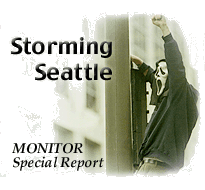
First Skirmishes
by Paul de Armond
 |
by Paul de Armond |
|
By
8AM, most of the key intersections had been seized by the protesters, now reinforced by their second wave. Meanwhile, at the Memorial Stadium at the Seattle Center, the gates are opening for the AFL-CIO rally, which is scheduled to begin at 10AM. Chartered busses from around the region have been on the road for some time, carrying a mixture of union members and protesters to Seattle. The AFL-CIO had done a mass mailing throughout Washington State, sending tasteful green postcards to non-union supporters of a variety of liberal and progressive organizations. "Join the March of the Century," the cards read. The AFL-CIO strategy of parading without protesting dovetailed neatly with the city plans for a minuscule protest and a mediagenic parade.
The Direct Action Network's goal was sufficiently broad to join together two major WTO opponents. The Direct Action Network protesters clustered around the international network of non-governmental organizations devoted to extending the principles of liberal democracy. The DAN factions can be distinguished by their varying focus on environmental or human rights issues. The second major WTO opponent was American organized labor, the AFL-CIO. In contrast to the Direct Action Network, the AFL-CIO is a hierarchical institution which emphasizes top-down command. There is little participation by rank and file in union decision-making, though ceremonial elections are sometimes held to legitimize leadership decisions. Essentially nationalist in outlook, the AFL-CIO policy goals are directed more at American politics and less at international issues. Simply stated, the AFL-CIO's strategic target was supporting and legitimizing President Clinton's actions at the conference through purely symbolic displays. As discussed later, Clinton acknowledged that there was considerable coordination between his administration and the AFL-CIO in regards to the parade and protests. Overall, the advantage went to the Direct Action Network, since their informational strategy effectively enclosed the coordinated strategy of the AFL-CIO and the federal government. As will be seen, at the critical moment in the street actions, the balance shifted to the Direct Action Network as non-union protesters and a few union members left the AFL-CIO parade and joined the street protests, effectively sealing the success of the Direct Action Network's day-long blockade.
Albion Monitor
February 29, 2000 (http://www.monitor.net/monitor) All Rights Reserved. Contact rights@monitor.net for permission to use in any format. | ||||||||